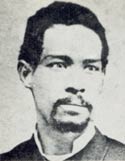Candelario Obeso
Candelario Obeso | |
|---|---|
 | |
| Born | Candelario Obeso Hernández 12 January 1849 Mompox, Bolívar |
| Died | 3 July 1884 (aged 35) Bogotá, Colombia |
| Occupation | poet |
| Nationality | Colombian |
Candelario Obeso (12 January 1849 – 3 July 1884) was a Colombian poet. He is known as a precursor of the Poesía Negra y oscura (black and dark poetry) in Colombia.
Life
He was a mulatto, born of a white hacendado and a black maid in Mompox, Colombia on 12 January 1849. He studied at Colegio Pinillos de Mompox. In 1886 he obtained an scholarship to do his higher studies at Colegio Militar de Bogotá, and a year later he entered the Universidad Nacional de Colombia where he started engineering, law and political science, but due to economical struggle, he was unable to graduate from any faculty.[1][2]
He had several jobs during short periods of time. Due to his friendship with influential personalities of the time, he was named consul in Tours, France and national interpreter in Panama. He also worked as a school teacher in Sucre and municipal treasurer of Magangué.[3][4]
He faced racial discrimination and economical struggle. He fell in love with a white high-society lady who rejected his poems on love and she soon got engaged to a rich man. Heartbroken, he shot himself in the chest and died in Bogotá a few days later.[1][5] His remains are in the cemetery of Mompox.[6]

Legacy
“Siendo probe alimales lo palomos; A la jente a sé jente noj enseñan; E su condúta la mejó cactilla; Hai en sus moros efertiva cencia!...”
He is known as the precursor of the Poesía Negra y oscura (black and dark poetry) in Colombia, a literary style that focused on describing the daily activities performed by the Colombian black communities. He wrote his narrative in the first person and using the language the Afrocolombian communities spoke.[8] An example of this is his first book of poems, Cantos Populares de mi Tierra, published by Imprenta de Borda in 1887.[7]
He also wrote La familia Pygmalion (1871), Lectura para ti (1878), Secundino el Zapatero (1880) and Lucha de la vida (1882).[9]
He translated into Spanish Shakespeare’s Othello, and works from Víctor Hugo, Byron, Musset, Longfellow, Goethe and Jonathan Lawrence.[10]
References
- ^ a b "Candelario Obeso: bogando en un río de letras". Red cultural del Banco de la República en Colombia. Retrieved April 19, 2019.
- ^ Ibarra, Marco. "Candelario Obeso: biografía y obras". Retrieved April 19, 2019.
- ^ "Candelario Obeso / Poemas". La cola de rata. Retrieved April 19, 2019.
- ^ Meza, Fernando (July 3, 2018). "¿Tinto… Obeso?". Panorama Cultural. Retrieved April 19, 2019.
- ^ "Muertes legendarias". Semana. July 7, 2003. Retrieved April 19, 2019.
- ^ Dier, Andrew (2017). Colombia. Moon. ISBN 978-1-63121-357-1.
- ^ a b Various authors (2011). Candelario Obeso Una apuesta pedagógica, estética y social. Bogotá: Instituto para la Investigación Educativa y el Desarrollo Pedagógico –IDEP–. pp. 19–25. ISBN 978-958-8780-00-9.
- ^ Emblin, Richard (March 6, 2014). "Obeso: Poet of the Magdalena". The City Paper. Retrieved April 19, 2019.
- ^ Valdelamar Sarabia, Lázaro; Ortiz Cassiani, Javier (2009). "La actividad intelectual de Candelario Obeso: entre el reconocimiento y la exotización". Cuadernos de literatura del Caribe e Hispanoamérica.
- ^ Jauregui, Carlos (1999). "Candelario Obeso: entre la espada del romanticismo y la pared del proyecto nacional". Revista Iberoamericana. 65: 188-189: 567–590.
- 1849 births
- 1884 deaths
- 19th-century Colombian poets
- National University of Colombia alumni
- People from Bolívar Department
- Suicides by firearm in Colombia
- English–Spanish translators
- German–Spanish translators
- Colombian translators
- Burials in Colombia
- Translators of Johann Wolfgang von Goethe
- Translators of William Shakespeare
- Colombian people of African descent
- 1880s suicides
